Without our pollinating bees, most of our vegetables and fruit won’t grow, nor would flowering plants survive! Which flowers do bees like the most? See the best flowers to attract bees to the garden—with the nectar, food, and pollen that bees are after!
Advertisement
I’m sure many of you have dealt with the frustration of seeing blossoms fall off your vegetable plants because they have not been pollinated. Bees are important to our whole ecosystem. Further, the bee population is at risk due to overuse of pesticides so it’s important to not only plant flowers that bees need the most, but to also never treat them with pesticides.
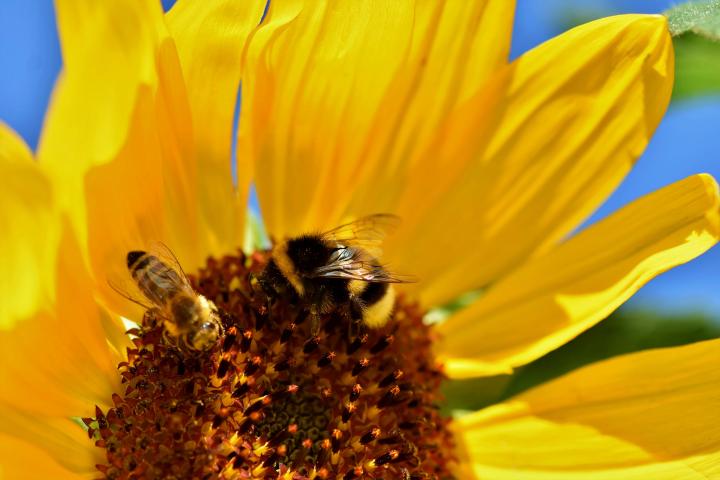
Sunflowers are packed with pollen—plus, their broad, semi-flat petals are an easy resting place for bees. See how to grow sunflowers.
Native Bees Are Pollinating Powerhouses
Most of the pollination is carried out by native pollinators—including flies, beetles, moths, and butterflies—but native bees are the unsung heroes. (Note: Honeybees are non-natives and not as important for widespread pollination.)
- There are over 4,000 species of bees native to North America, ranging from the world’s smallest bee—the 2mm long fairy bee (Perdita minima)—found only in the desert southwest, to the large carpenter bees that reach 40mm long.
- No matter their size, all native bees rely on blooming plants for sugary nectar and protein-packed pollen to feed themselves and their offspring.
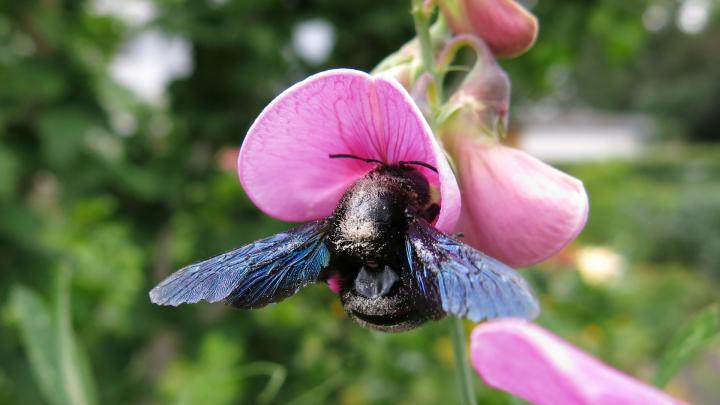
A big carpenter bee can muscle his way into flowers like this sweet pea. Learn how to grow sweet peas.
To keep bees well supplied with the nourishment they need, we need to have flowers in bloom all season long. To offer something for everyone, grow a variety of shapes and sizes.
Choosing Flowers for Bees
Bees prefer some types of flowers over others for a number of reasons. Generally, it comes down to the shape and color of the flower. Here are some things to keep in mind when you’re planning to plant flowers for bees:
- A bee’s flower preference depends on the length of its tongue! Some bees have long tongues that can easily access nectar in tubular-shaped blossoms like penstemon, columbine, and honeysuckle, while those with short tongues go for daisies, asters, and sunflowers. Small bees like small florets and composite flowers, while big bumblebees and carpenters like larger flowers. Try to plant a mix of different flower shapes and sizes to attract a variety of bee species to your space.
- Flower color matters. Bees can’t see red, which is a color more attractive to hummingbirds and butterflies. Bees are drawn to purple, blue, white, and yellow.
- Pollinators generally prefer native plants over non-natives, since they have co-evolved together. Natives are usually low-maintenance plants, adapted to your region and easy to find for sale. Species plants have an advantage over cultivars when it comes to attracting pollinators and giving them what they need.
- Research has found that fancy forms of native plants—sometimes called “nativars”—are not as attractive or useful to the bees as the original species of the plants. You may have found this out yourself if you planted one of those fancy coneflower varieties.
- Hydrangea ‘Annabelle’ is the same genus and species as native smooth hydrangea (H. arborescens), yet it draws far fewer pollinators. Why? Many cultivars have lost the fragrance, pollen, nectar, and flower shapes that pollinators need.
- A hybridized plant that was bred to be sterile or contain no nectar will not benefit a pollinator at all.
- Also avoid planting double-flowering varieties. They have less pollen and it can be harder for the bees to access it with extra petals in the way. Stick close to the original flower form instead of going fancy and the bees will thank you for it.
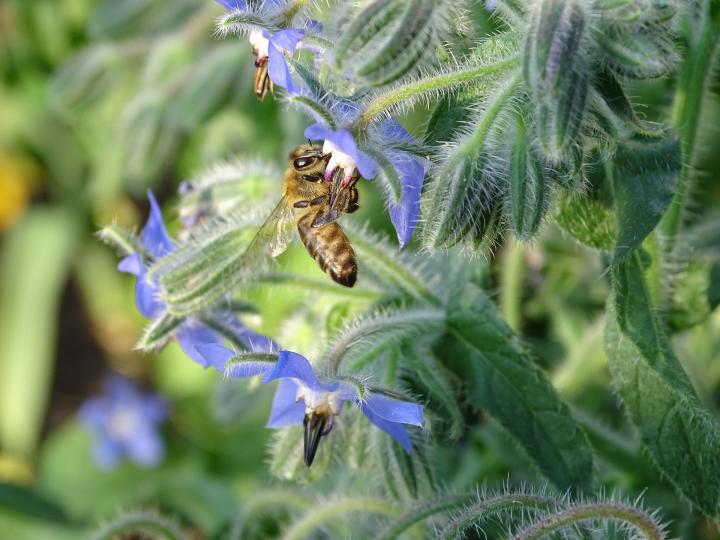
Borage is an edible annual herb and also a great companion, deterring bad bugs away while attracting bees. See how to grow borage.
Which Flowers Are Best for Bees?
Perennials offer the highest quality nectar and pollen but there are exceptions. Some bees are specialists, like the squash bee that prefers only squash, pumpkin, and gourd blossoms. The most effective pollinators are the generalists that get their food from a wide range of plants. This includes not only native trees and perennials but some non-natives like crimson and white clovers and annuals as well.
- Annuals have the advantage of blossoming all season long. Bees flock to alyssum, cleome, zinnias, sunflowers, salvia, calendula, and verbena.
- Your culinary herbs such as sage, thyme, borage, lavender, chives, dill, basil, oregano, rosemary, and mint can do double duty. Plant them throughout the vegetable garden, let some of them flower, and they will draw in the pollinators to your other plants.
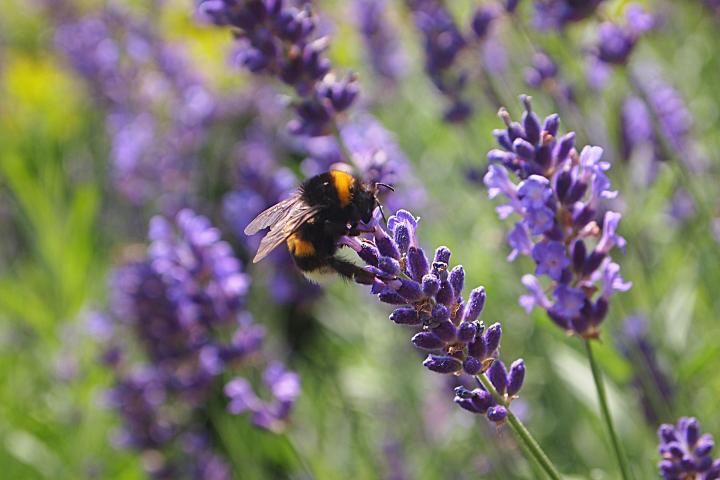
Lavender is an aromatic perennial herb that flowers all summer-long. And it’s edible! See how to grow lavender.
Early-Season Flowers for Bees
The eternal struggle for bees in temperate zones is finding enough food in late winter and early spring, when most of nature is still sleeping! Here’s what we can plant to help them out:
- Some early blooming trees and shrubs to consider are vernal witch hazel, maples, willows, serviceberry, and redbud. They flower when not much else is in bloom yet.
- Early blooming fruits including cherry, plum, raspberry, blackberry, and blueberries.
- Spring-flowering bulbs are also popular with early awakening bees.
- Some spring perennials to grow include golden alexanders, larkspur, dianthus, wild columbine, ajuga, lupine, baptisia, and pulmonaria.
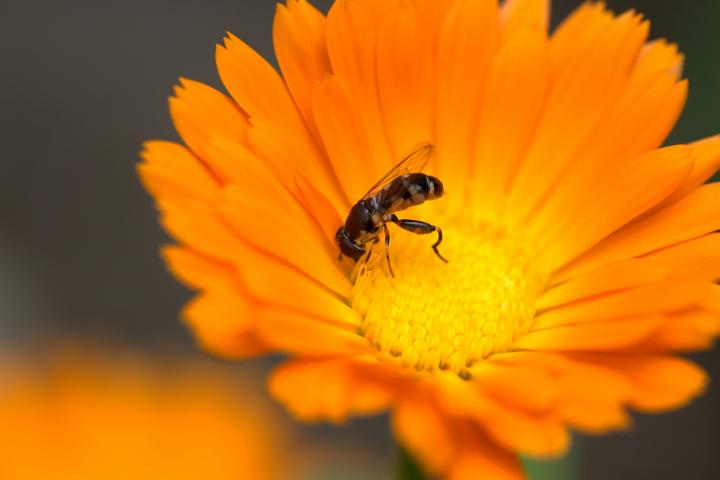
Calendula (also called pot marigold) is an early bloomer which is very important bee forage! See how to grow calendula.
Mid-Season Flowers for Bees
Mid-season flowers such as anise hyssop, black-eyed Susans, coneflowers, catmint, cleome, penstemon, globe thistle, milkweed, monarda (bee balm), coreopsis, daisies, phlox, gaillardia, and yarrow are bee magnets.
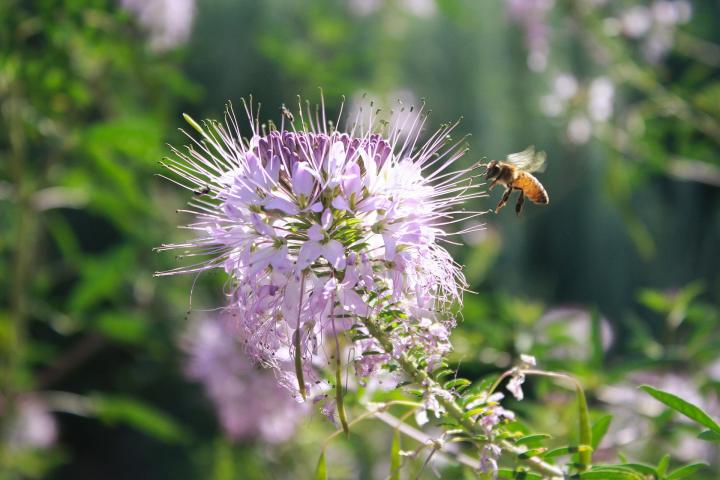
Cleome, or “spider flower,” are beloved by pollinators and produce a long season of blooms.
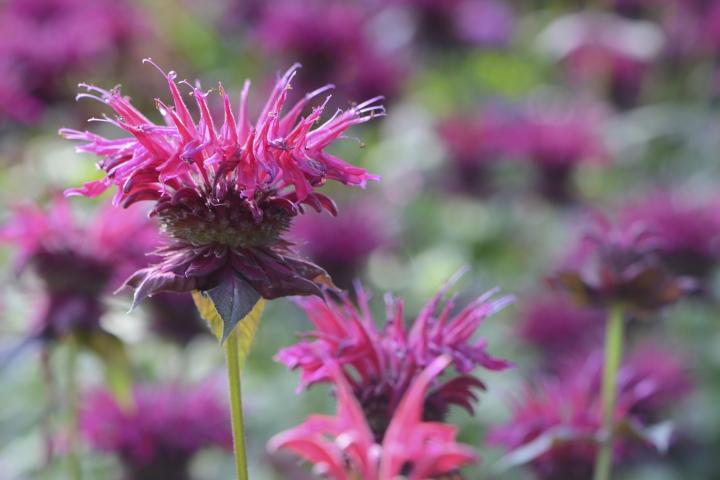
“Bee balm” is an apt name of this flower, which is native to North America. Bees love it! See how to grow bee balm.
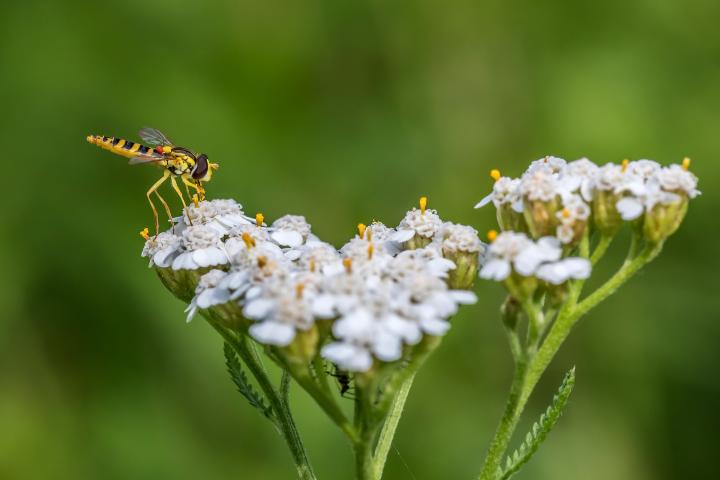
Yarrow has an easy landing pad which makes it easy for pollinators to take a rest! See how to grow yarrow.
Late-Season Flowers for Bees
Bees are active until the weather cools down in late fall and still need to feed. Grow some late bloomers like dahlias, asters, ironweed, goldenrod, Joe Pye weed, rudbeckias, and helianthus to keep the party going. Bumblebees love bottle gentian, too!
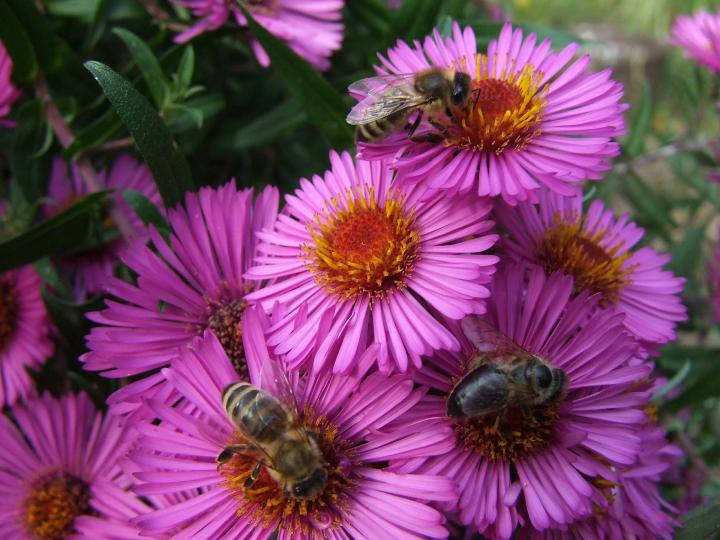
New England asters offer pollen and nectar into fall. See how to grow asters.
These are just a some of the bee plants that are widely grown. You can find plant lists specific to your region at xerces.org.
Creating a Bee-Friendly Habitat
Native bees need more than pretty flowers to survive. We need to provide water, shelter, and nesting sites. Banish pesticides and other poisons from your yard.
When shopping for plants, look for chemical-free ones. Systemic insecticides can make the whole plant toxic—nectar and pollen included!
Learn more about native bees! They are fascinating creatures.

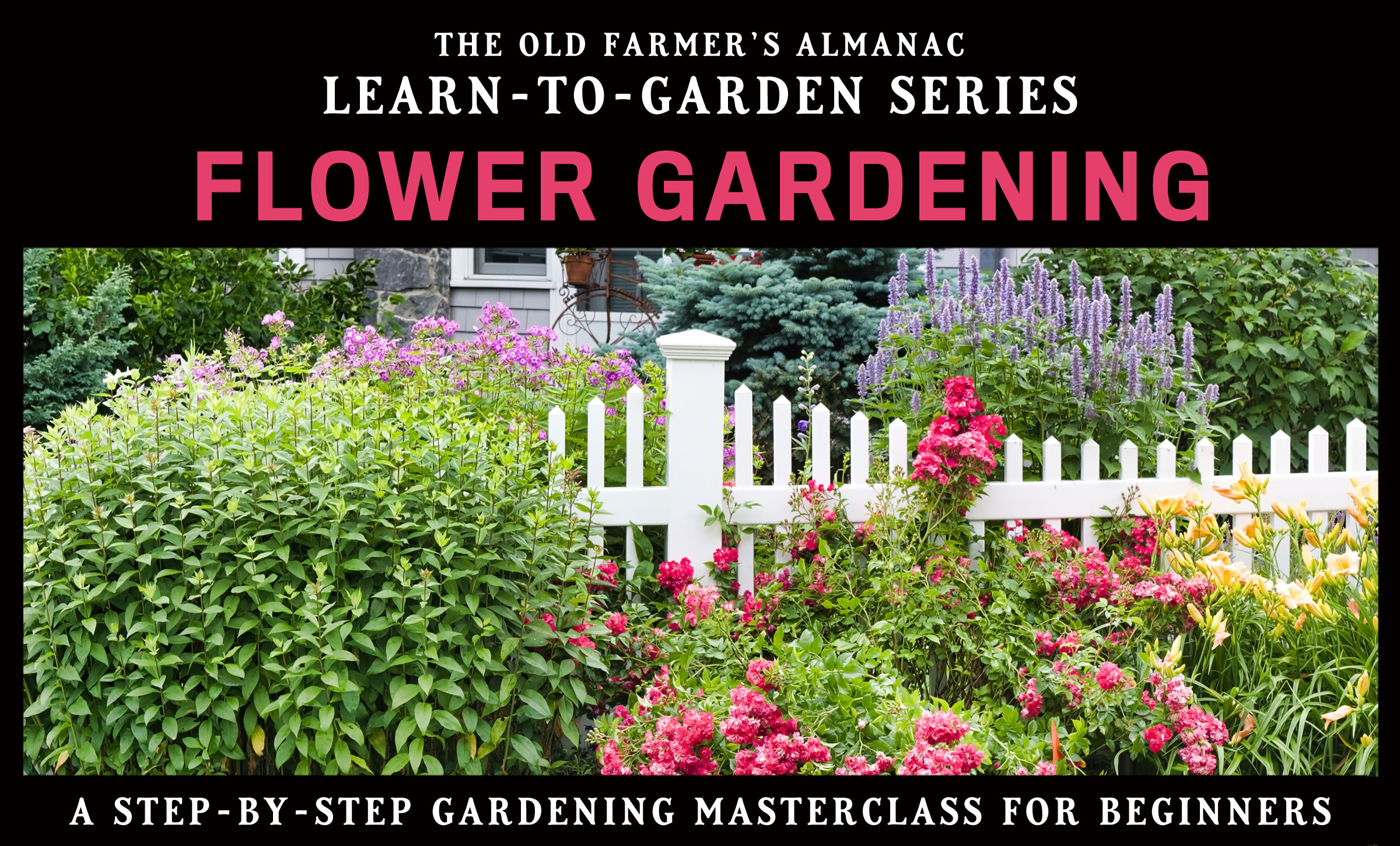


















Comments